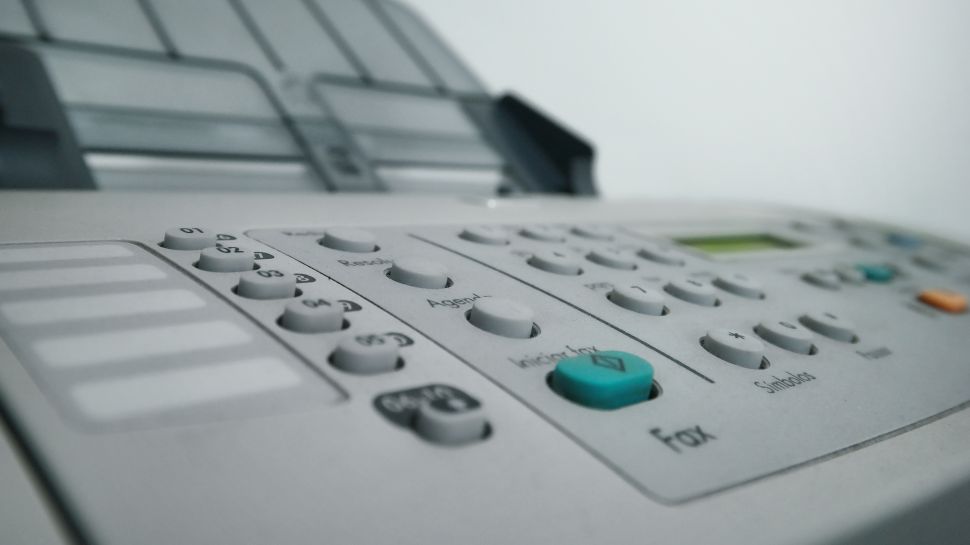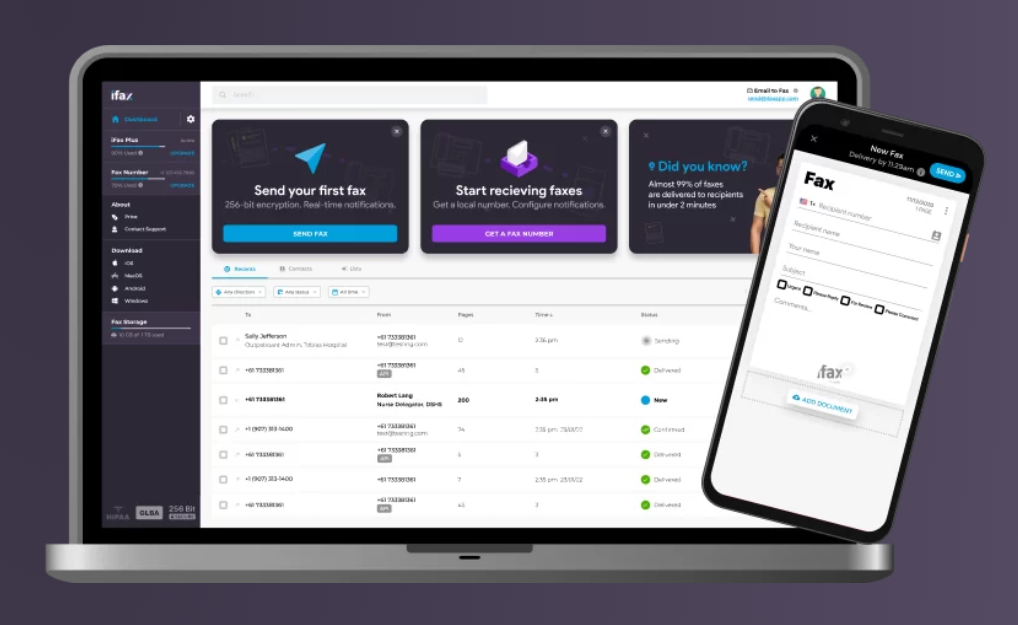
Healthcare professionals often need to exchange documents via fax. More so, American healthcare professionals must comply with the Health Insurance Portability and Accountability Act (HIPAA), which has strict rules to protect sensitive medical information for everyday individuals.
Fortunately, there are online faxing services compliant with HIPAA. These services offer a secure yet convenient way to fax medical documents between professionals. Confirmation of faxes usually occurs via email, and you can download or save received faxes securely on the Internet.
We want to explain the five most important things to consider when choosing a HIPAA-compliant faxing service. Before we start, let’s take a deeper look at HIPAA.
Understanding HIPAA
The Health Insurance Portability and Accountability Act (HIPAA) is a U.S. federal law enacted in 1996 under the Clinton administration. This law established a formal set of rules and regulations to guarantee the privacy and security of patients' protected health information (PHI). The rules apply to any American healthcare organization dealing with sensitive medical records.
HIPAA compliance involves several activities, including:
- Formulating policies and procedures to protect PHI within a healthcare organization.
- Keeping PHI secure in private locations.
- Conducting frequent risk assessments to detect and fix security threats.
- Reporting any data breaches to the affected individuals and the Department of Health & Human Services (HHS).
- Using encrypted file-sharing platforms to protect patients’ PHI.
Faxing may be out of vogue, but many hospitals and healthcare organizations still use it to share information. After HIPAA was enacted, hospitals could not just use any fax platform but, instead, only platforms that met the strict privacy requirements of the new law. Hence, many online faxing services tweaked their platforms to comply with HIPAA.
Any HIPAA-compliant must have advanced security features to prevent leaks and data theft. Such features include end-to-end encryption, audit trails, access controls, two-factor authentication, etc. Medical data breaches can cause severe damages, so hospitals can’t just choose any platform to start sharing information; the U.S. government imposes severe penalties for HIPAA non-compliance. Patients also won’t want to interact with any organization that was previously negligent with sensitive records.
Likewise, an online faxing service must be reliable enough to serve critical medical functions. You don’t want a situation where a healthcare worker couldn’t receive vital information about their patient’s health and ended up causing complications.
You must consider various factors when looking for a HIPAA-compliant faxing platform, mainly
- Security
- User-friendliness
- Pricing
- Customer support
- Third-party integrations
Below, we’ll dive deeper into these factors and why they’re necessary in choosing an online faxing service for medical professionals.
Factors to consider when choosing a HIPAA-compliant faxing service
1. Security
HIPAA has strict rules to protect patients’ data privacy and security. Violating this law can bring significant consequences, including fines and criminal prosecution. Hence, security is the first thing to consider when choosing an online faxing service for medical information.
Firstly, your online faxing tool should have sophisticated encryption features. The industry standard is 256-bit encryption, which uses keys of 256 bits to encrypt data and make it virtually impenetrable by brute force. The faxes you send will be converted into code that only the recipient can decrypt; if a hacker intercepts the information, it'll be useless to them because they don't have the required encryption key.
Assuming a hacker decides to brute force a 256-bit-encrypted platform, they’ll have to generate trillions of possible key combinations in a short moment, which is impossible with current technology.
Another key security feature is two-factor authentication. This feature requires two modes of identification before granting access to your online faxing account. The first is the correct credentials (username and password), and the second is a unique one-time PIN sent to a linked email address or phone number. No one can access your account without this code, even if they somehow get your password. Microsoft, a cybersecurity powerhouse, estimates that two-factor authentication prevents 99.9% of account attacks.
HIPAA-compliant faxing platforms usually have audit trails that let IT administrators see who faxed a specific document and who received it. This way, any leaks or breaches can be traced easily.
Don’t forget to use strong passwords on your end. Avoid passwords that are easy to guess. An ideal password should combine letters, numbers, and symbols that a hacker can’t guess randomly. If you need help, password management tools like LastPass and 1password have built-in password generators and can also help you manage passwords for numerous accounts.
2. User friendliness
You need an online faxing service with an intuitive interface that’s simple to navigate. User-friendly software makes life easier in all industries. Healthcare professionals are already stressed enough and don’t need one more thing complicating their work. A user-friendly interface makes it easy to fax documents just how you want and avoid mistakes that could bring severe penalties, e.g., faxing the wrong document or faxing the correct document to the wrong person.
Most online faxing services work via web browsers. You can log into your account and send documents to other users or check the documents you’ve received from others. When you send a fax, you’ll usually input an email address that the platform notifies about the document sent to their account. This way, people will always know when they receive documents from you, and you’ll get notified when other people send you documents.
Some online faxing platforms also offer a mobile app, which allows you to send and receive faxes on the go. Mobile apps are convenient to use almost everywhere, including in places where it’s unsuitable to use a laptop, e.g., during a commute or while walking.
Take, for example, iFax, a well-known online faxing service. iFax has a responsive interface you’ll likely enjoy using. Features are arranged neatly on your dashboard, allowing you to choose the right one and avoid making mistakes. iFax has apps for desktops (Windows and macOS) and mobile phones (iOS and Android). You can access the platform from either option and fax documents seamlessly; every user has a unique fax number you can use to send them documents.

3. Pricing
Pricing is crucial when choosing a HIPAA-compliant faxing platform or any other software. These platforms aren’t free, meaning choosing something you can afford in the long term is essential. You don’t want to experience issues because your organization’s IT budget is not enough for the online faxing service you picked.
Most faxing platforms charge monthly or annual subscriptions for each user, which makes it easy to forecast how much you'll pay in the long run. Small organizations with limited cash flow can choose the monthly subscription option for all users. Larger organizations with higher budgets can choose annual plans. But note that many platforms give significant discounts on their yearly plans, so paying annually might be more economical than monthly.
Massive organizations (1,000+ employees) can negotiate custom deals with online faxing providers. These deals usually include bulk discounts and custom features the organization might request. Many platforms provide contact information for their sales team if you want to negotiate a custom deal.
4. Customer Support
Customer support is vital when choosing any software and even more vital for a HIPAA-compliant online faxing service. Recognize that things can go wrong anytime, and you might need direct support to resolve the issues. Hence, you need a faxing service with a reliable support team to call upon when required.
What contact options does your vendor offer? (most allow you to contact them through email, telephone, or live chat). If so, are they available 24/7? You don’t want to be left to fend for yourself at certain hours of the day because the support team is not available.
Customer service doesn’t stop at direct support. Your platform should also provide an extensive knowledge base with user guides, manuals, and solutions to frequently encountered issues. You should also have access to detailed technical documentation about your online faxing service. This way, you can solve some problems yourself and don’t have to wait for direct support for every little issue.
A good way to judge customer service is by checking reviews from previous users. These reviews tell you if your desired online faxing service has a good reputation for customer support or not.
5. Third- party integrations
No single platform can give you all the features you want, so an online faxing service needs to have third-party integrations that provide extra functionality. For instance, you might want to append your digital signature to a document before faxing it, but your online faxing service doesn’t have this feature. Instead, it can be integrated with an e-signature platform, allowing you to sign documents before sending them to their destination.
Third-party integrations can also allow you to sync files between your online faxing app and an external cloud storage service. For instance, you can transfer files from the platform to Google Drive or Dropbox at the click of a button.
The Bottom Line
We have explained the five critical factors to consider when looking for a HIPAA-compliant online faxing service. Follow our tips, and you’ll likely choose the best platform for your organization. For more information, check out our list of the best online fax services of 2024.







